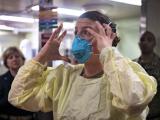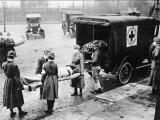Oct 12, 2009 (CIDRAP News) – A collection of new studies is demonstrating once again the ability of the pandemic H1N1 virus to make some people desperately sick and is raising questions about the potential strain on critical-care resources this fall and winter.
Researchers in Mexico and Canada reported that severely ill patients in the early weeks and months of the epidemic spent upwards of 12 days in intensive care units (ICUs) on mechanical ventilation, according to two reports published online today by the Journal of the American Medical Association.
About 17% of the Canadian patients and 41% of the Mexican patients died. Both groups were relatively young overall, and sizable minorities were obese. Hospitals in both countries struggled to meet the demand for intensive care, and four of the Mexican patients died before they could get into the ICU.
A third report says that 68 patients with confirmed or suspected H1N1 in Australia and New Zealand were treated with the sophisticated heart-lung bypass technology called extracorporeal membrane oxygenation (ECMO) during the countries' recent winter flu season. The patients, most of whom were young, were on the treatment for a median of 10 days, and 14 of them (21%) died.
Given that 80% to 90% of ICU beds are filled at any given time, the findings suggest that the US critical care system could come under heavy strain as the pandemic spreads this fall and winter, several professionals involved in critical care told CIDRAP News.
They agreed with two JAMA editorial writers who said the studies highlight the need for hospitals to "develop explicit policies to equitably determine who will and will not receive life support should absolute scarcity occur."
Canadian and Mexican studies
The Canadian researchers, a large team led by Anand Kumar of St. Boniface Hospital in Winnipeg, Man., gathered data on all H1N1 patients treated in Canadian ICUs from Apr 16 through Aug 12. They identified 162 confirmed cases and 6 probable ones.
The mean age of the patients was 32.3 years, and 50 were children. A third of the patients were obese, and 67% were female, a gender imbalance that was unexplained. The group included 43 aboriginal Canadians, and 52 patients were from the greater Winnipeg region.
Eighty-one percent of the patients required mechanical ventilation for a median of 12 days, which was also their median time in intensive care. Fifty-one patients had major underlying conditions, with chronic lung disease, obesity, hypertension, and smoking the most common. Evidence of bacterial pneumonia was seen in 24%. The death toll was 29 patients (17%), including four children.
Critical care capacity in the Winnipeg area was "seriously challenged" at the peak of the outbreak in June, with all regional ICU beds filled, much as in the SARS (severe acute respiratory syndrome) epidemic in Toronto in 2003, the report says.
In Mexico, researchers tracked 58 patients who were critically ill with confirmed or suspected H1N1 cases at six hospitals from March 24 to Jun 1. They were among 899 patients with confirmed or suspected cases who were admitted to the hospitals during that time; many of them faced delays in admission to the ICU, and four died in emergency departments.
The median age of the patients was 44.2 years; only two were children. Obesity was the most common "comorbid" condition, found in 21 (36%) of the 58 patients, followed by smoking, hypertension, and diabetes.
All but two patients received mechanical ventilation for acute respiratory distress syndrome (ARDS). Twenty-four patients (41%) died. Those who survived were in the ICU a median of 13.5 days and on a ventilator a median of 15 days (many received ventilation outside the ICU).
In the JAMA editorial, Douglas B. White, MD, MAS, and Derek C. Angus, MD, MPH, write that the similarities in the main findings of the Canadian and Mexican studies are striking. They cited the relatively young age of the patients and the prolonged and severe hypoxemia, which required frequent use of rescue therapies. They also note that there were no documented cases of nosocomial transmission of H1N1 in either case series.
ECMO cases Down Under
The third report, by a large team called the Australia and New Zealand Extracorporeal Membrane Oxygenation Influenza Investigators, covers all patients treated with ECMO for H1N1-related ARDS in the two countries from June through August.
The group identified 68 patients with confirmed (61) or suspected (7) H1N1 at the 15 institutions that had ECMO capability. Their median age was 34 years; there were three children and no elderly people. The most common underlying conditions were obesity, in 50%; asthma, 28%, and diabetes, 15%. Another 15% of the patients were pregnant or in the postpartum period.
Fourteen patients died by the close of the study period, while another 6 remained in intensive care.
The report says the 68 patients represent an ECMO treatment rate of 2.6 per million people, and the ECMO capacity was never exceeded. Given a similar incidence of ECMO use for H1N1 patients, "rough estimates are that the United States and European Union might expect to provide ECMO to approximately 800 and 1,300 patients" this winter, the authors state.
Possible shortages ahead
Several experts involved in critical care said the reports released today suggest the potential for rough times ahead, given the small surge capacity in the US critical care system.
For example, Daniel O'Laughlin, MD, medical director for emergency preparedness at Abbott Northwestern Hospital in Minneapolis, said that only 10% of the 513 adult, acute-care ICU beds in the Twin Cities area were unfilled at the time of an assessment in early September.
Likewise, John L. Hick, MD, an emergency medicine physician and director of disaster preparedness at Hennepin County Medical Center in Minneapolis, commented by e-mail, "We know that most days we are running 80-90% capacity (and a few weeks ago had to cancel a few elective cases due to lack of ICU beds), so it won't take much to bring the house down."
Last February, said O'Laughlin, several hospitals in the region ran out of ventilators, for reasons unrelated to flu. They couldn't obtain any extra ones from suppliers immediately and therefore had to postpone some elective procedures that would've required the machines.
The JAMA reports also make clear that not just any ventilator will be adequate for treating patients with severe H1N1 illness, according to Robert Dunne, MD, vice chief of emergency medicine at St. John Hospital and Medical Center in Detroit.
"There are stockpiles of ventilators, but they tend to be very simple ventilators more for nerve agents" such as botulinum toxin, he said. "Very complex ventilation is needed in these flu patients, and these stockpiled vents may be of use to free up better ventilators but likely have little use for the flu patients.
"Given the geographic progression of disease, it may be possible to move vents from areas that are having decreased activity to areas that are starting to peak, but this requires a national strategy that is not there at this time."
Nick Kuhnley, manager of respiratory care at North Memorial Medical Center in Robbinsdale, Minn., said sophisticated ventilators are needed in particular for patients who are obese, which was the case for many of those in the JAMA reports.
"The common factor for that is that these people are extremely difficult to ventilate; they're very restricted," he said. "It's the same exact problem as for pregnant women—you've encroached on your thoracic space. When you get the pneumonias in a restricted lung, it is very severe."
Kuhnley said many hospitals have a "hodgepodge" of ventilators. He said his center has 10 that are "high-acuity," and another 19 are medium acuity, adding, "Medium-acuity ones may or may not be effective for a lot of these severe cases."
However, O'Laughlin said ventilators in state and federal stockpiles, while not as sophisticated as some high-end models, would be adequate for most patients, including most influenza patients.
Another resource that could cause problems in the pandemic is the tubing, or circuits, that connect a ventilator to the patient's airway, said Kuhnley. He said hospitals and health officials in Minnesota have been working to ensure an adequate supply of circuits and have made progress in the past year, so that they should be able to weather the pandemic, provided the distribution system remains "mostly intact."
But he said hospitals in other states may not be as well prepared.
The experts noted that the availability of ECMO is very limited in the United States, as is true in Australia and New Zealand. Dunne said probably only one or two institutions in each state or region have the capability.
"Since [ECMO] is not 'standard of care,' it is not included in preparedness efforts, and maybe it should not be," O'Laughlin commented. "Some discussion of this is important especially given the pediatric case mix."
First pandemic in critical care era
A noteworthy aspect of the H1N1 situation is that it's the first pandemic to occur since critical care emerged as a specialty, said O'Laughlin.
"I think one of the key things is that both the Canadian and Mexican articles identified that most of the patients that did present requiring critical care resources could be supported through the illness," he said. "This is the first pandemic we've experienced in the era of critical care medicine. . . . We do have the ability to utilize these critical care resources and have an impact on the patients that have experienced the 2009 H1N1 influenza and have success in having them recover."
But he cautioned that there will be difficult choices if and when ICU space and equipment run short in the course of the pandemic. "That's where it becomes absolutely necessary for hospitals to have those discussions on how to equitably distribute the scarce resources," he said.
Kumar A, Zarychanski R, Pinto R, et al. Critically ill patients with 2009 influenza A (H1N1) infection in Canada. JAMA 2009 Oct 12;302(17):(Early online publication) [Full text]
Dominguez-Cherit G, Lapinsky SE, Macias AE, et al. Critically ill patients with 2009 influenza A (H1N1) in Mexico. JAMA 2009 Oct 12;302(17):(Early online publication) [Full text]
The Australia and New Zealand Extracorporeal Membrane Oxygenation Influenza Investigators. Extracorporeal membrane oxygenation for 2009 influenza A (H1N1) acute respiratory distress syndrome. JAMA 2009 Oct 12;302(17):(Early online publication) [Full text]
White DB, Angus DC. Preparing for the sickest patients with 2009 influenza A (H1N1). (Editorial) JAMA 2009 Oct 12;302(17):(Early online publication)



















